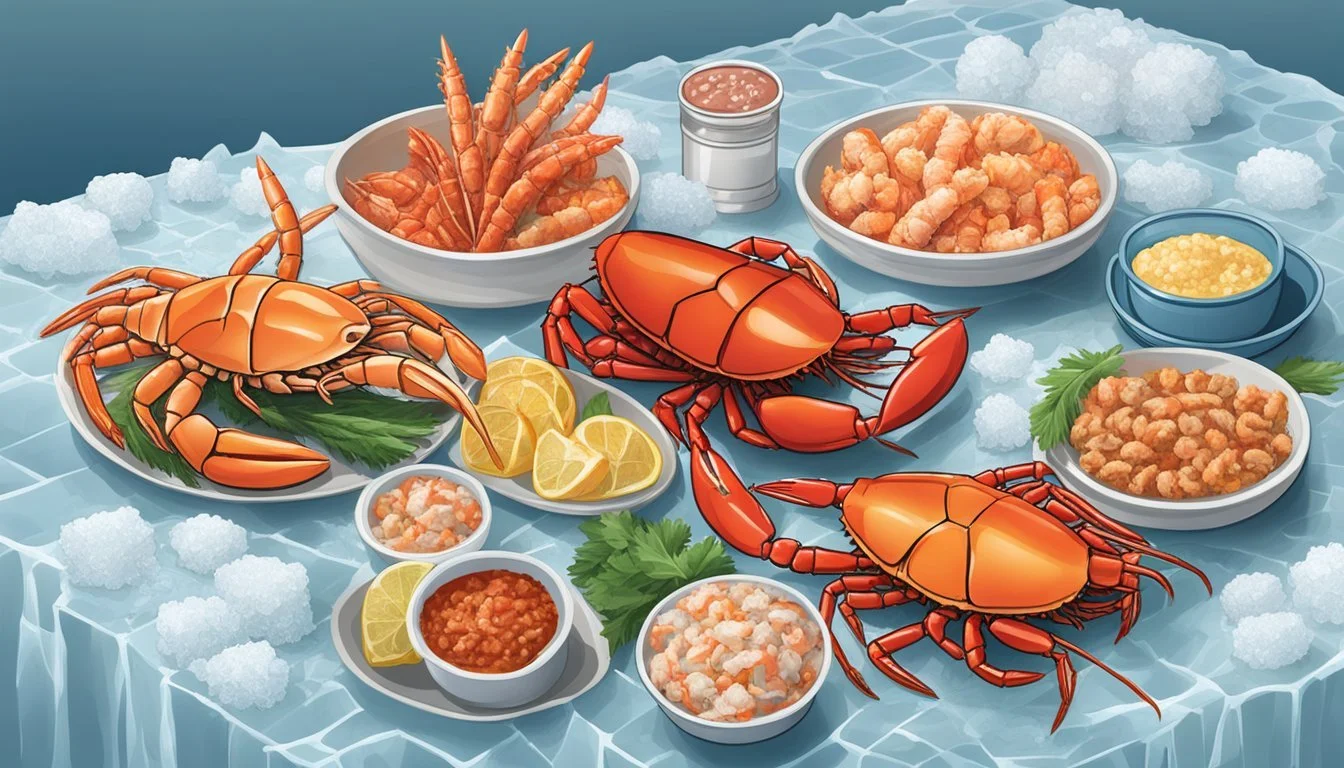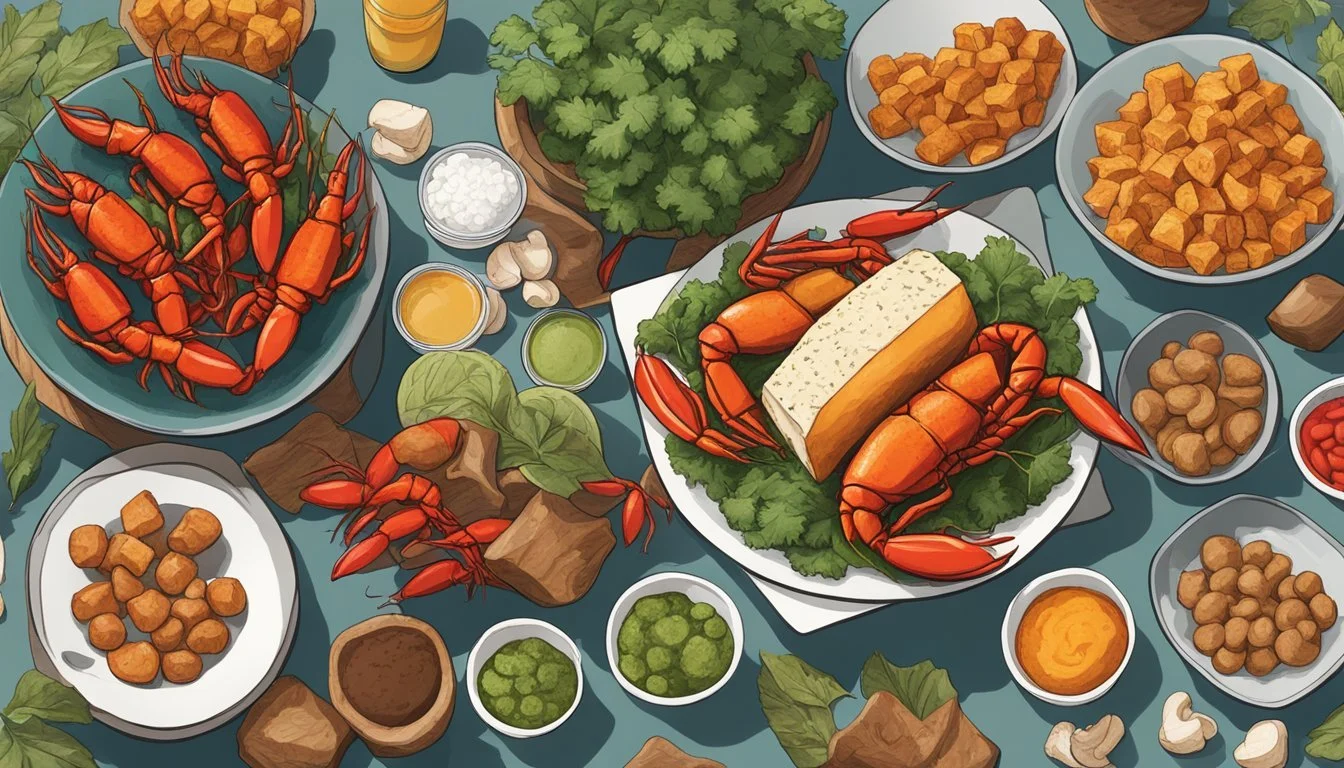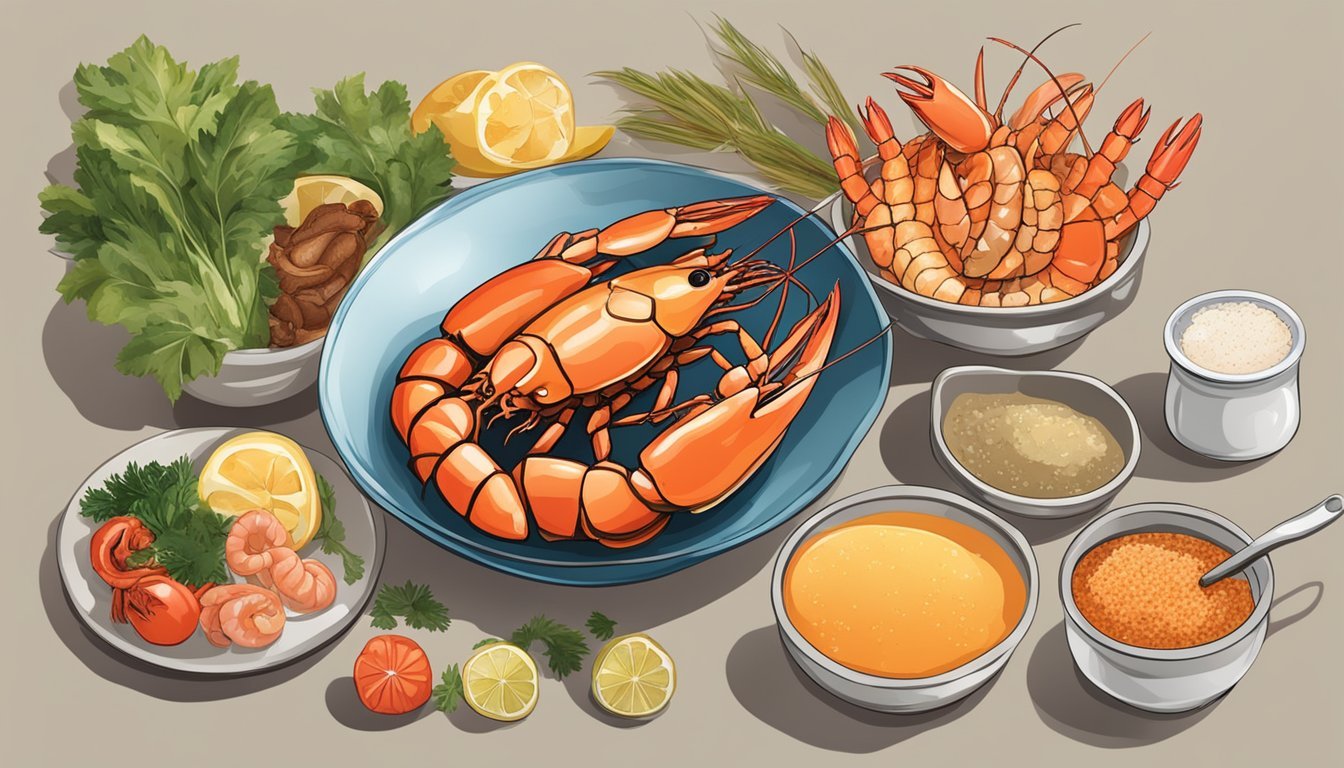Crawfish Substitutes
Best Alternatives for Seafood Dishes
Finding the right substitute for crawfish can elevate your dish, offering flexibility without compromising on flavor. Lobster makes an excellent alternative due to its similar taste and texture; both are shellfish with a tender, succulent profile that works well in boils, stews, and bisques.
Other shellfish such as shrimp also serve as an effective replacement, sharing many characteristics with crawfish. Although smaller in size, shrimp can be just as versatile in recipes, providing a comparable seafood experience.
For those exploring plant-based options, jackfruit and portobello mushrooms are popular choices. These alternatives offer the stringy and tender textures needed to mimic that of crawfish in various vegan and vegetarian dishes. The use of seaweed and soy sauce can further enhance the oceanic flavor, making the transition seamless and satisfying.
Understanding Crawfish and Its Unique Qualities
Crawfish possess a distinct flavor and texture, making them a favorite in seafood dishes. They are also rich in essential vitamins and minerals while presenting dietary considerations due to possible shellfish allergies.
Crawfish Basics: Flavor and Texture
Crawfish, also known as crayfish or crawdads, resemble small lobsters and have a similar savory taste. The meat is delicate and slightly sweet, with earthy and briny notes. This blend of flavors sets it apart from other seafood.
The texture of crawfish meat is tender and succulent, akin to a hybrid between lobster and shrimp. Their firm yet slightly fibrous texture makes them ideal for various preparations like boils, stews, and bisques.
Nutritional Profile: Vitamins and Minerals in Crawfish
Crawfish are rich in nutrients, offering significant health benefits. They are a great source of protein and low in fat, making them suitable for various diets. Key vitamins found in crawfish include B12, which supports nerve function and red blood cell formation.
Additionally, crawfish are packed with essential minerals like zinc, iron, magnesium, and phosphorus. These minerals contribute to immune function, energy production, and bone health. Incorporating crawfish into meals can enhance nutritional intake without adding excessive calories.
Crawfish Allergies and Dietary Restrictions
Crawfish fall under the category of shellfish, making them a common allergen. Shellfish allergies can trigger severe reactions and should be taken seriously. Symptoms might include hives, swelling, difficulty breathing, and in extreme cases, anaphylaxis.
Individuals with shellfish allergies should avoid crawfish and dishes containing it. Proper food labeling and awareness are crucial in preventing allergic reactions. For those with dietary restrictions, seeking alternative protein sources that provide similar nutrients may be essential.
Seafood-Based Substitutes for Crawfish
Seafood stands out as a versatile option when looking for substitutes for crawfish. The following substitutes offer a range of textures and flavors, making them suitable for various dishes.
Shrimp and Prawns: Closest Cousins in Texture and Flavor
Shrimp and prawns are popular substitutes for crawfish due to their similar texture and mild sweetness. Available in numerous varieties, ranging from white to brown, these shellfish can be used in boils, stews, and bisques.
They are often more accessible and affordable. Prawns, slightly larger than shrimp, provide a comparable tender and juicy experience when cooked properly. In recipes, shrimp and prawns can be seasoned and prepared similarly to crawfish, achieving a familiar taste and texture profile.
Crab and Lobster Substitutes: Exploring Texture and Taste
Crabs and lobsters share a succulent and delicate texture with crawfish. Lobsters, typically found in saltwater, deliver a rich, buttery flavor, making them ideal for gourmet seafood dishes.
Crabs, on the other hand, offer a sweet and slightly briny taste. Whether using lump crab meat or whole crabs, these shellfish can be integrated into various recipes that traditionally call for crawfish, providing a deliciously close alternative.
Scallops and Monkfish: Subtle Flavors for Crawfish Alternatives
Scallops and monkfish, though not immediately similar to crawfish, offer delicate and versatile flavors. Scallops have a sweet, buttery taste with a tender, creamy texture. They work well in dishes where the flavor of the seafood needs to stand out.
Monkfish, known as the "poor man's lobster," offers a firm texture and mild flavor, making it suitable for substituting crawfish in more robust dishes. Their unique characteristics allow them to be a sophisticated alternative in various culinary contexts.
Surimi and Pollock: Versatility and Availability
Surimi, often made from Alaskan pollock, is a processed seafood product that mimics the texture of shellfish like crab and crawfish. It is widely used in imitation seafood products like crab sticks.
Alaskan pollock itself is a versatile fish with a mild flavor, used in everything from fish sticks to fillets. Both surimi and pollock are cost-effective, with high availability, making them practical substitutes for crawfish in a variety of recipes without compromising on texture or flavor.
Plant-Based and Vegetarian Crawfish Alternatives
Many plant-based and vegetarian options can effectively replace crawfish in various dishes. These substitutes provide unique textures and flavors, while also offering nutritional benefits such as high protein and fiber content.
Mushrooms: A Versatile Substitute for Texture
Mushrooms are an excellent plant-based alternative to crawfish, particularly king oyster mushrooms. Their dense, chewy texture mimics the mouthfeel of seafood, making them ideal for dishes like vegan boils, stews, and bisques.
When cooked, king oyster mushrooms absorb flavors well, making them a versatile ingredient in a range of recipes.
Other mushrooms such as shiitake and portobello can also be used, offering different textures and enhancing the overall taste profile of the dish.
Tofu and Tempeh: High-Protein Seafood Substitutes
Tofu and tempeh are popular vegetarian and vegan alternatives due to their high protein content and ability to absorb surrounding flavors. Tofu, made from soybeans, offers a soft, yet firm texture that can be cubed or sliced for various dishes.
Tempeh, which is fermented soybeans, has a firmer texture and a slightly nutty flavor.
Both can be marinated to replicate the taste of crawfish, making them suitable for seafood stews and sautés. Tofu is also versatile enough to be fried or baked, further increasing its utility in plant-based seafood recipes.
Jackfruit and Hearts of Palm: Unique Textural Substitutes
Jackfruit and hearts of palm provide unique textures that closely resemble the flaky, tender quality of seafood. When cooked, jackfruit's fibrous consistency makes it a popular ingredient in vegan seafood dishes, such as tacos and sandwiches.
Hearts of palm, often used in salads and ceviches, provide a tender and delicate bite that can easily replace crawfish in many recipes.
Both jackfruit and hearts of palm are rich in fiber and low in calories, making them not only tasty but also nutritious substitutes for crawfish. These ingredients prove especially useful in plant-based and vegetarian preparations, adding both texture and flavor.
Novel Substitutes for Specific Crawfish Dishes
When seeking substitutes for crawfish in various dishes, exploring novel and creative options can maintain the dish's character. Below are innovative alternatives suitable for specific culinary applications.
Creating a Vegan Scampi: Alternative Ingredients and Method
For a vegan twist on crawfish scampi, king oyster mushrooms prove to be an excellent substitute. Their firm texture replicates the mouthfeel of shellfish. Slice the mushrooms into bite-sized chunks and marinate them in a mix of olive oil, garlic powder, lemon juice, and dried parsley.
Cook the mushrooms in a hot pan until they're golden brown. Serve with linguine, a splash of white wine, vegan butter, and freshly chopped parsley. The rich flavors and textures will satisfy even the most discerning palate.
Homemade Fish Alternatives for Crawfish Pies and Bakes
Creating a fish alternative for crawfish pies and bakes can be achieved using white fish like haddock or cod. These fish have a flaky texture and mild flavor that complements creamy fillings. Dice the fish into small pieces, seasoning with salt, pepper, and a dash of lemon zest.
Combine the fish with a mixture of sautéed onions, garlic, and a creamy sauce made from dairy or plant-based milk. Pour into a pie crust or casserole dish and bake until golden brown. This approach ensures a deliciously satisfying meal.
Marinating Techniques for Seafood and Plant-Based Substitutes
Effective marinating techniques enhance the flavor of both seafood and plant-based crawfish substitutes. For seafood like shrimp or prawns, a marinade of lemon juice, olive oil, minced garlic, and fresh herbs works wonders. Let the seafood soak for at least 30 minutes to absorb the flavors.
For plant-based options, such as jackfruit, a similar marinade can infuse the flesh with savory goodness. Adding smoked paprika or liquid smoke provides an additional depth of flavor. These marinated ingredients can be used in a variety of dishes, from stews to casseroles.
Enhancing Substitutes with Complementary Flavors
When replacing crawfish in recipes, the goal is to mimic its distinctive taste and texture. Adding specific herbs, spices, sauces, and marinades can greatly enhance the substitutes, creating a flavorful and satisfying dish.
Using Herbs and Spices to Mimic Crawfish's Distinctive Flavor
Herbs and spices play a crucial role in emulating the unique taste of crawfish. Parsley provides a fresh, slightly peppery note that complements seafood well. Combining it with paprika adds a subtle smokiness and sweetness, reminiscent of traditional crawfish dishes.
Thyme and bay leaves can add earthy undertones, delivering depth to stews and boils. For a touch of heat, incorporating cayenne pepper can simulate the mild spiciness often found in Cajun crawfish recipes. Blending these spices thoughtfully can bring a substitute like lobster or crab closer to the flavor profile of crawfish.
Sauces and Marinades: Creating Depth with Fish Sauce and Seaweed
Incorporating sauces and marinades enhances the complexity of seafood substitutes. Fish sauce offers a rich umami flavor, intensifying the taste profile and adding a salty, slightly fermented quality that enhances the resemblance to crawfish.
Nori or seaweed, frequently used in sushi, can introduce a deep, briny taste. When ground into a powder and mixed into marinades, seaweed can replicate the oceanic flavor of crawfish. Adding seaweed to shrimp or crab dishes can significantly elevate the overall taste, providing an authentic seafood experience.
By combining these elements, one can achieve a well-rounded and satisfying flavor that stands up well to crawfish in various recipes.
Considerations for Choosing Crawfish Substitutes
When selecting substitutes for crawfish, various factors come into play to ensure that the alternatives are safe, nutritious, and environmentally responsible. Key considerations include accounting for allergies, nutritional value, cost, and sustainability.
Allergies and Food Sensitivities: Finding Safe Options
For individuals with shellfish allergies, it's critical to find substitutes that don't trigger allergic reactions. Bay Bugs and prawns can be good options for those who are not allergic to these alternatives. However, some may need to avoid all shellfish altogether and rely on non-shellfish alternatives such as shrimp with careful scrutiny for allergens. Be thorough in reading labels and consulting with medical professionals when choosing substitutes.
Nutritional Considerations: Balancing Protein, Vitamins, and Fats
When considering nutritional content, it's essential to balance protein, vitamins, and fats. Crawfish are high in vitamin B12, iron, zinc, and selenium, which contribute to good health. Lobster provides similar nutritional benefits and has a comparable taste and texture. Shrimp is another alternative rich in protein and low in saturated fats. When choosing substitutes, it's important to match the nutritional content of crawfish as closely as possible to maintain a balanced diet.
Cost and Sustainability: Factors Influencing Selection
Cost and sustainability are critical factors. Some alternatives, like lobster, can be more expensive due to supply and demand dynamics. Bay Bugs might offer a more cost-effective solution in regions where they are abundant. Sustainability involves considering the ecological impact of harvesting these substitutes. Overfishing and unsustainable farming practices can harm the environment, so choosing responsibly sourced seafood options is crucial for minimizing ecological footprint.
Each of these considerations helps in making an informed choice that not only satisfies culinary needs but also aligns with health and environmental responsibilities. Balancing these aspects ensures that substitutes for crawfish are both practical and beneficial.
Concluding Thoughts on Crawfish Substitutes
Crawfish is a unique seafood delicacy often used in various culinary dishes. Yet, there are several excellent substitutes that can provide similar flavors and textures.
Seafood Alternatives:
Shrimp: Similar in taste, shrimp is often a popular substitute. It comes in various species, either freshwater or saltwater.
Lobster: Another good option, though lobsters are larger and may offer a slightly different texture.
Dried Shrimp Powder: Provides a concentrated seafood flavor, making it suitable for recipes needing crayfish powder.
Crustaceans: Crustaceans like Bay Bugs, especially common in Australia, can be a superb substitution. They resemble the texture and taste of crawfish closely.
Nutritional Considerations: Crawfish, like other seafood, is rich in vitamin B12 and calcium. When seeking alternatives, shrimp and lobster also contain significant amounts of these nutrients.
Plant-Based Diet: For those on a plant-based diet, achieving similar umami flavors can be done with ingredients like soy products. Fermented bean paste and soy sauce are effective in adding depth to recipes traditionally using crawfish.
For West African dishes, Maggi crayfish cubes and Worcestershire sauce are popular options carrying similar essence.
Summary Table:
Substitute Description Shrimp Similar taste, different water habitats Lobster Larger size, slightly different texture Bay Bugs Close in flavor, available in Australia Dried Shrimp Powder Concentrated seafood flavor Plant-Based Soy sauce, fermented bean paste for umami Crayfish Cubes Convenient seasoning for West African dishes
Various substitutes can cater to different dietary needs and preferences without compromising much on flavor or texture. By considering these alternatives, cooking versatile and delicious meals without crawfish is entirely feasible.









